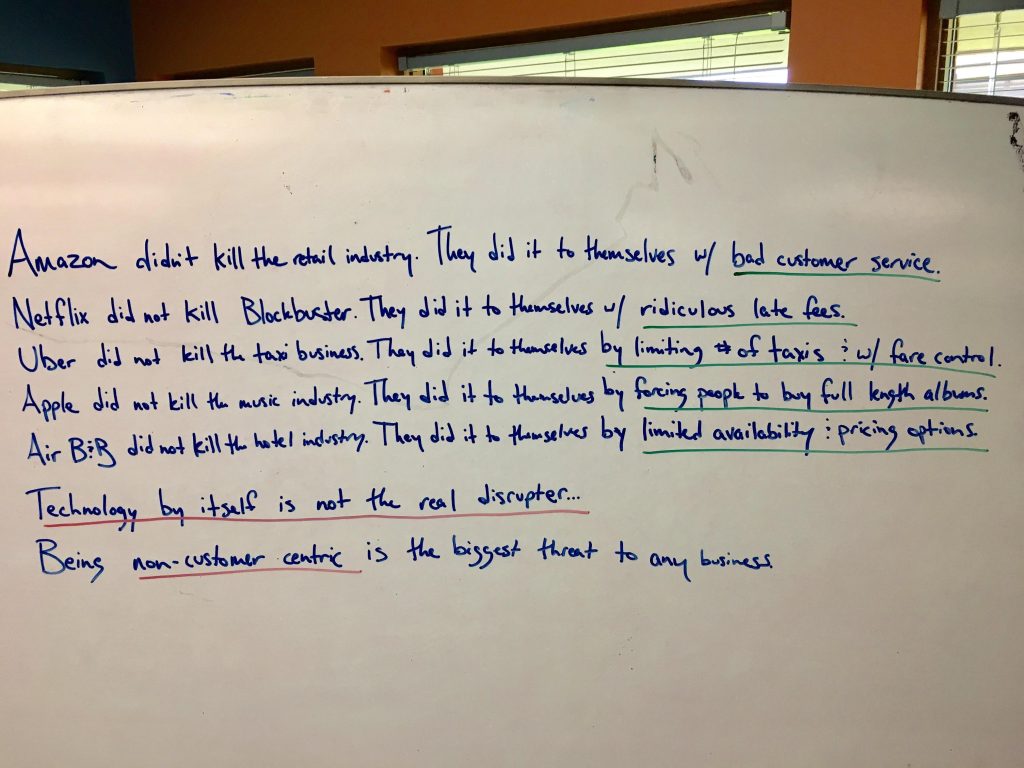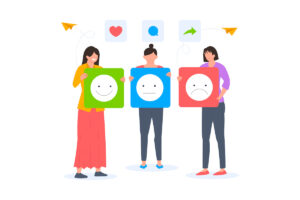How do you grow as a business? Where do you generate your insight – have you plucked ideas from the sky or listened to colleagues’ sitting around a meeting table? Yes, these ideas can be valid, but are they intuitions that are truly coming from a customer-centric perspective?
In short – are you listening to what your customers are telling you? A shift from brand-centric to customer-centric innovation can help you to provide products and services that create value for your customers and keep your brand relevant.
By humanizing your business and innovating around your customers instead of doing so blindly, you can foster a human brand that progresses in an empathetic way.
There are plenty of examples of new tech that has completely revolutionized and challenged traditional institutions. In some cases, technology has replaced products that have become obsolete, as customers favor ease-of-use and modernity over tiered services that are outdated.

Image by Alberto Brea
But this didn’t have to happen and the trajectory wasn’t written in the stars for some brands. Here are a few examples of brands that failed to listen to customers:
- Amazon didn’t kill the retail industry. It was self-inflicted because of bad customer service.
- Netflix didn’t kill Blockbuster. They did it to themselves with over-inflated late fees and outdated products.
- Uber didn’t kill the taxi service. They did it to themselves by limiting the number of taxis with fare control.
- Apple didn’t kill the music industry. They did it to themselves by only allowing people to buy full-length albums.
- Air BnB didn’t kill the hotel industry. They did it to themselves with limited availability and pricing options.
Technology, by itself, couldn’t affect these industries, it was the fact that businesses using new technology decided to use it in a customer-centric way. Failing to listen to your customers is the biggest threat to any business.
So how can you humanize your business and safeguard it against disruptive innovation from other competitors? 93% of executives think innovation is crucial but only 34% believe they have the strategy in place to innovate properly.
Recognize
Innovation isn’t just for digital whizz-kids and cool new start-ups – every business needs to be innovating and putting the processes and frameworks in place to do this. The first step towards strong customer-centric innovation is to recognize the need for it in your company.
Smaller start-ups might have more flexibility or the ability to easily pivot, but you can use the tools and experience at your disposal to make a change.
Organize
It’s really important that you make time and space for your employees to innovate. This might be setting aside time in their schedules to brainstorm ideas and work on new strategies or it could be encouraging them to speak to customers and clients and find out what they’re thinking.
Creating a culture where innovation is facilitated will lead to more ideation. Google is one of the best innovator examples and their 80/20 policy gives employees 20% of their working time to develop new creative projects. Forming small, dedicated teams for customer-centric research will help to constantly put your business on a forward footing.
Customer-Input
Social media has shifted the traditional power bases away from businesses and this is a good thing. We’re closer to our customers together and it’s never been easier to interact and learn from them. Good innovation is about keeping up with customer’s expectations and their expectations have never been higher.
Consumers aren’t just comparing your customer service with other competitors in your industry; it’s with any other business that they interact with. So, no matter the area of expertise, deliver the best customer service, regardless of whether others in your industry are doing it.
This is the same in terms of innovation – even if things don’t rapidly change in your industry, they are in other areas. Customers see innovation in other areas and expect it from your business too.
Social Channels
Using social media to understand your customers is a good first step. Social listening will enable you to learn lessons from your customers on a mass scale and turn their thoughts into actionable plans.
You need to put strategies in place that allow you to take customer input and transform it into data that you can interpret and use to illustrate why you’re innovating in a certain way. Looping customer feedback into your brand’s decision-making process will make it more robust.
Focus on customer reviews, comments and interactions and use customer intelligence platforms to create meaning from your findings.
Listen
On a basic human level, we like to feel listened to – whether that’s in a conversation with friends or in our place of work. Customers want this feeling too – acting on customer feedback and providing tangible change can enhance brand loyalty create more value for your customers.
Don’t get left behind by failing to notice trends and patterns in customer expectations. Innovate in a customer-centric way and you’ll be moving in a direction that meets customers in the middle, instead of watching from the sidelines.






